Business and Economy
Mindanao’s growth to drive PH progress: WB exec

The growth and development of Mindanao could drive the country’s full progress if the government and other stakeholders succeed in unlocking the region’s potentials. (PNA photo)
DAVAO CITY — The growth and development of Mindanao could drive the country’s full progress if the government and other stakeholders succeed in unlocking the region’s potentials.
This prospect was expressed by World Bank (WB) Country Director for Brunei, Malaysia, the Philippines and Thailand, Mara Warwick, during the presentation of the Philippines Mindanao Jobs Report at the Marco Polo Hotel Davao on Friday.
Warwick underscored the need for the national and local governments, the private sector, and other players to be more focused, interconnected and coordinated in planning and implementing programs and reforms to unlock Mindanao’s potentials.
She said that in the long run, progress in the entire country deends on the growth and development of Mindanao.
“Mindanao holds about one-fourth of the country’s population and one-third of the total number of poor Filipinos. Therefore, significantly reducing national poverty hinges on reducing poverty in Mindanao. Ensuring Mindanao’s prosperity benefits the entire country,” Warwick said during the launch of the report, which was made in collaboration with the Mindanao Development Authority (MinDA) and the Philippine Business for Social Progress (PBSP).
The 92-page report, a strategy on Mindanao’s development, outlines three recommendations to speed up growth that creates more and better jobs and reduces poverty in the region.
Warwick said the report has gone through an extensive consultation process.
Following the study, she said, WB came up with three recommendations around three development areas.
These are raising the productivity of Mindanao’s agriculture and fisheries sector and improving connectivity to markets; boosting human capital and social protection for the poor; and addressing the drivers of conflict and strengthening institutions in conflict-affected areas.
After seeing the disparity and sharp regional contrasts in Mindanao, Warwick said the WB saw the need to develop a strategy for Mindanao to hasten its development.
She cited as an example, the country’s gross domestic product (GDP) per capita at USD2,953. However, in Mindanao, the GDP per capita is only USD1,800 while the Autonomous Region in Muslim Mindanao (ARMM) is only USD576.
“Such regional disparities are further reinforced by the human development indicators in Mindanao with the greatest challenge in ARMM,” Warwick said.
She said that more than half of ARMM’s population are poor and more than half of its employed population are in agriculture with 80 percent of them working as subsistence farmers, living precariously from crop to crop.
Warwick said the recommendations are either under various stages of implementation or in the pipeline of projects prepared by MinDA, other government agencies, and the local government units.
A number of the projects are also supported by WB and other development partners.
“What the report tries to achieve is a reinforcement of the idea that no single project, program or reform can solve Mindanao’s challenges,” she said. “If we all work together — the government, the private sector, civil society, and development partners — Mindanao’s potential today can be unlocked for a more vibrant Mindanao tomorrow where Filipinos will have better chance to have better life,” she added.
Warwick said the World Bank Group partnership strategy for the country focuses on scaling up support for peace-building and development in Mindanao.
World Bank is supporting the government’s program to raise agricultural productivity and improve connectivity from farm to market, boost education, skills and employability of the youth, and help build resilient communities.
On the other hand, MinDA chairman Secretary Datu Hj. Abul Khayr Alonto vowed to pursue projects and programs for Mindanao under the administration of President Rodrigo R. Duterte.
Alonto said it has been two years of talking about projects and it is now time to implement the projects detailed under the Philippine Development Plan of 2017-2022.
He emphasized the need to spur activities more efficiently with the support of all stakeholders to achieve the objectives set in the Mindanao Jobs Report.
Alonto sees Mindanao’s agriculture and agri-based industries as the most prominent economic drivers.
The MinDA chairman is also banking on Mindanao’s growth corridor strategy, which was designed to improve infrastructure, enhance linkages between growing and lagging regions, and ensure balanced growth.
This would lead to greater connectivity that can reduce transportation costs and improve the competitiveness of small farmers and other producers.
Alonto said there are already 35 projects that facilitate the movement of people, goods, and services, such as ports and airports improvements, roads, and bridges that are given priority for national government funding.
He said 21 priority projects have a funding of PHP17 billion.
“It is high time to implement (these projects), not only to propel Mindanao but to provide jobs,” Alonto said.





















